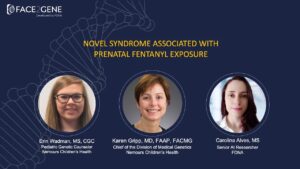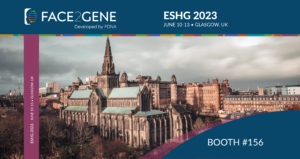In March, FDNA reached out to clinicians and patients globally as part of the Year of Discovery to collect and analyze patient data from a category of syndromes known as RASopathies, in partnership with Blueprint Genetics and the Noonan Syndrome Foundation. A research team at FDNA, dedicated to making new discoveries with this data, has released the first round of results in the year-long initiative.
The initial analysis aimed to see if an algorithm could be trained to recognize facial differences in patients that have genes specific for RASopathies, such as Costello Syndrome, Leopard Syndrome and Noonan Syndrome.
Below are five such discoveries made so far that are presented as visualizations of the typical facial shape and form (called a “gestalt”) of patients with these syndromes. The data behind these visualizations is now available for use in facial analysis of patients using the Face2Gene CLINIC application, available free of charge at www.Face2Gene.com.
The results:
Neurofibromatosis syndrome type 1
NF1 gene

Typical facial structure and form (gestalt) of patients with NF1 gene
Costello Syndrome
HRAS gene

Typical facial structure and form (gestalt) of patients with HRAS gene
CFC Syndrome type 1
BRAF gene

Typical facial structure and form (gestalt) of patients with BRAF gene
Noonan Syndrome with Multiple Lentigines (Leopard Syndrome) type 1
PTPN11 gene

Typical facial structure and form (gestalt) of patients with PTPN11 gene and Leopard Syndrome
Noonan Syndrome type 1
PTPN11 gene

Typical facial structure and form (gestalt) of patients with PTPN11 gene and Noonan Syndrome
When a clinician analyzes a patient using Face2Gene, the clinician will be presented with a list of syndromes that contain similar morphology, as well as a list of phenotypes and genes that the artificial intelligence engine recommends the clinician should consider in their evaluation.
To learn about all the syndromes that have benefited from Face2Gene technology, or to get involved, please contact FDNA, or see more ways to get involved below.
In addition to these discoveries in March, Face2Gene has added several new syndromes to its facial analysis capabilities, including:
- Scalp-Ear-Nipple Syndrome; SENS
- Spondyloepiphyseal Dysplasia Congenita; SEDC
- Yunis-Varon Syndrome; YVS
- Deafness, Onychodystrophy, Osteodystrophy, and Mental Retardation; DOORS
- Geroderma Osteodysplasticum; GO
- Immunoosseous Dysplasia, Schimke Type
- Miller-Dieker Lissencephaly Syndrome; MDLS
- Cartilage-Hair Hypoplasia; CHH
- Mental Retardation, X-Linked, Syndromic 11; MRXS11
- Siderius X-Linked Mental Retardation Syndrome; MRXSSD
- Fabry Disease
- Partington X-Linked Mental Retardation Syndrome; PRTS
- Chromosome 4q21 Deletion Syndrome
- Hartsfield Syndrome; HRTFDS
- Thanatophoric Dysplasia
- X-Linked Mental Retardation – Xp22.11 – PTCHD1 Mutations
- Neurologic, Endocrine, and Pancreatic Disease, Multisystem, Infantile-Onset; IMNEPD
- Trichothiodystrophy
- Loeys-Dietz Syndrome
- Microcephaly – autosomal recessive – hypomyelination – PYCR2 mutations
- Noonan-like syndrome – loose anagen hair, SHOC2
- Mannosidosis, Alpha B, Lysosomal; MANSA
- Multiple Sulfatase Deficiency; MSD
Get Involved:
Healthcare Professionals: Do you have cases to upload that can help Face2Gene recognize overgrowth syndromes and accelerate advancements? Upload them through the app or at www.Face2Gene.com, or use the Face2Gene RESEARCH app to conduct your own research.
Patients and Families: Ask your doctor to add your or your child’s case to Face2Gene. The personal information will only be accessible to your doctor but the de-identified data may help others who are battling a rare disease. Click here for more information.



